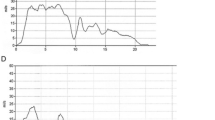Abstract
This study aimed to evaluate the voiding characteristics of primary school children by using questionnaires and non-invasive diagnostic tools. The voiding characteristics of 212 healthy children in two primary schools were evaluated with ultrasound for bladder wall thickness (BWT) in association with the Pediatric Lower Urinary Tract Symptom Score (PLUTSS), familial questionnaire, uroflowmetry (UF) and urinalysis. Most of the children (70%) had achieved urinary and fecal continence between the ages of 18 months and 36 months. Twenty-five per cent of heathy children void fewer than four times or more than seven times per day. Ninety percent of children had a PLUTSS within normal ranges (< 9). Fifteen percent of patients had a uroflowmetric pattern other than bell-shaped. The peak and average flow rates were higher in girls. Enuresis nocturna was detected in 10% of children. None of the children had documented urinary tract infection. The average BWT from posterior wall at full bladder in healthy children was 1.1 mm. The anterior and posterior BWT measurements before and after micturition were found to be thicker in boys. Regarding the UF pattern, in post-voiding measurements in children with abnormal UF pattern, the bladder walls were thicker. Non-invasive tests in non-symptomatic children showed a range of variability, and these deviations should be kept in mind during the evaluation of voiding characteristics of a child. The symptom scoring system, with the high sensitivity and specificity rates it possesses, is one of the promising tools for this purpose.

Similar content being viewed by others
References
Lee SD, Sohn DW, Lee JZ, Park NC, Chung MK (2000) An epidemiological study of enuresis in Korean children. BJU Int 85:869–873
Hellström AL, Hansson E, Hansson S, Hjälmås K, Jodal U (1990) Incontinence and micturition habits in 7-year-old Swedish school entrants. Eur J Pediatr 149:434–437
Nevéus T, von Gontard A, Hoebeke P, Hjälmås K, Bauer S, Bower W, Jørgensen TM, Rittig S, Walle JV, Yeung CK, Djurhuus JC (2006) The standardization of terminology of lower urinary tract function in children and adolescents: report from the Standardisation Committee of the International Children’s Continence Society. J Urol 176:314–324
Akbal C, Genc Y, Burgu B, Ozden E, Tekgul S (2005) Dysfunctional voiding and incontinence scoring system: quantitative evaluation of incontinence symptoms in pediatric population. J Urol 173:969–973
Müller L, Bergstrom T, Hellstrom M, Svensson E, Jacobsson B (2000) Standardized ultrasound method for assessing detrusor muscle thickness in children. J Urol 164:134–138
Mattsson SH (1994) Voiding frequency, volumes and intervals in healthy schoolchildren. Scand J Urol Nephrol 28:1–11
Farhat W, Bagli DJ, Capolicchio G, O’Reilly S, Merguerian PA, Khoury A, McLorie GA (2000) The dysfunctional voiding scoring system: quantitative standardization of dysfunctional voiding symptoms in children. J Urol 164:1011–1015
Farhat W, McLorie GA, O’Reilly S, Khoury A, Bagli DJ (2001) Reliability of the pediatric dysfunctional voiding symptom score in monitoring response to behavioral modification. Can J Urol 8:1401–1405
Upadhyay J, Bolduc S, Bagli DJ, McLorie GA, Khoury AE, Farhat W (2003) Use of the dysfunctional voiding symptom score to predict resolution of vesicoureteral reflux in children with voiding dysfunction. J Urol 169:1842–1846
Bartkowski DP, Doubrava RG (2004) Ability of a normal dysfunctional voiding symptom score to predict uroflowmetry and external urinary sphincter electromyography patterns in children. J Urol 172:1980–1985
Chrzan R, Czernik J, Apoznanski W, Patkowski D, Siekanowicz P (2005) Uroflowmetry in children—is it necessary to repeat the study in a single patient? Eur J Pediatr Surg 15:26–29
Szabo L, Fegyverneki S (1995) Maximum and average urine flow rates in normal children—the Miskolc nomograms. Br J Urol 76:16–20
Amaro JL, Trindade Filho JC, Vercesi LA, Agostinho AD, Goldberg J, Trindade JC (1996) Urinary flow in children: correlation with age, body height and body surface area. J Urol (Paris) 102:85–86
Bower WF, Kwok B, Yeung CK (2004) Variability in normative urine flow rates. J Urol 171:2657–2659
Gutierrez Segura C (1996) The study of urinary flow in 3 to 14 year-old children. Urinary flow rate nomograms. Cir Pediatr 9:91–97
Shaikh N, Abedin S, Docimo SG (2005) Can ultrasonography or uroflowmetry predict which children with voiding dysfunction will have recurrent urinary tract infections? J Urol 174:1620–1622
Müller L, Jacobsson B, Marild S, Hellstrom M (2001) Detrusor thickness in healthy children assessed by a standardized ultrasound method. J Urol 166:2364–2367
Bachelard M, Sillen U, Hansson S, Hermansson G, Jodal U, Jacobsson B (1999) Urodynamic pattern in asymptomatic infants: siblings of children with vesicoureteral reflux. J Urol 162:1733–1737
Cvitkovic-Kuzmic A, Brkljacic B, Ivankovic D, Grga A (2002) Ultrasound assessment of detrusor muscle thickness in children with non-neuropathic bladder/sphincter dysfunction. Eur Urol 41:214–218
Author information
Authors and Affiliations
Corresponding authors
Appendices
Appendix 1: The first questionnaire about demographic features and voiding characteristics

Appendix 2: The second questionnaire (PLUTSS)

Rights and permissions
About this article
Cite this article
Dogan, H.S., Akpinar, B., Gurocak, S. et al. Non-invasive evaluation of voiding function in asymptomatic primary school children. Pediatr Nephrol 23, 1115–1122 (2008). https://doi.org/10.1007/s00467-008-0776-3
Received:
Revised:
Accepted:
Published:
Issue Date:
DOI: https://doi.org/10.1007/s00467-008-0776-3




